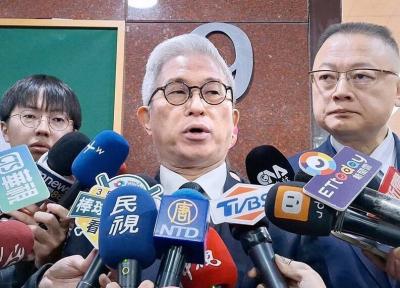Taiwan has not yet reached a point where it can export masks to diplomatic allies amid the COVID-19 pandemic, the Ministry of Foreign Affairs said yesterday, dismissing as misinformation online reports that it gave away masks to curry favor with a diplomatic ally.
“Taiwan provides med-ical aid to diplomatic allies based upon specific circumstances,” Minister of Foreign Affairs Joseph Wu (吳釗燮) said, adding that the supplements donated by Taiwan were all purchased locally in allied countries, in accordance with their needs.
“The time is not yet ripe” for Taiwan to export medical supplies, such as surgical masks, to diplomatic allies, until it is able to satisfy domestic demand, Wu said.
He was answering questions from reporters about reports that the ministry contravened the export ban by donating 100,000 masks to Paraguay, despite a domestic shortage.
The ministry on Saturday issued a statement rebutting the accusation, saying it had informed the authorities about the circulating misinformation.
Wu yesterday told a meeting of the legislature’s Foreign and National Defense Committee that the masks Taiwan provided to Paraguay were purchased in other Latin American countries at US$0.4 each and were not made in Taiwan.
However, restricted by the limited output of manufacturers in that region, Taiwan was able to give only 100,000 — instead of 1 million — masks to help the pandemic-hit ally, he said.
Wu added that Taiwan is facing a serious diplomatic challenge from China, which had contacted Paraguay and offered to donate masks.
Because of China’s suppression and poaching of allies, Taiwan has only 15 diplomatic allies, mostly in Latin America and the Caribbean.
Taiwan imposed a provisional ban on mask exports in late January after it reported the first confirmed case of novel coronavirus infection.
The ban, which was to last until Feb. 23, has been extended to April 30. The government has also requisitioned masks nationwide.
Lawmakers also asked Wu about Taiwan’s mask agreement with the US in their joint efforts to combat COVID-19.
Under the joint statement signed on March 18 by Wu and American Institute in Taiwan Director Brent Christensen, the US promised to reserve raw materials for 300,000 medical protective suits for Taiwan, while Taiwan agreed to provide 100,000 masks per week to the US when its production capacity has stabilized.
Wu confirmed that it is a formal “government-to-government” statement, although there are no formal diplomatic ties between the two nations.
As for when Taiwan would begin to supply the US with 100,000 masks per week, Wu said the two sides are still discussing the details.
Besides, the US has not yet decided when it would begin shipments of raw materials for 300,000 medical protective suits for Taiwan, Deputy Minister of Foreign Affairs Hsu Szu-chien (徐斯儉) said.
Taiwan needs 1 million medical protective suits and there are only two companies in the world — one in Japan and the other in the US — that produce key materials for the product, Vice Minister of Economic Affairs Wang Mei-hua (王美花) said.
Although a Taiwanese company produces medical-grade cloth for protective suits, its output can only satisfy 10 percent of domestic demand, Wang said.

Taiwan is to commence mass production of the Tien Kung (天弓, “Sky Bow”) III, IV and V missiles by the second quarter of this year if the legislature approves the government’s NT$1.25 trillion (US$39.78 billion) special defense budget, an official said yesterday. Commenting on condition of anonymity, a defense official with knowledge of the matter said that the advanced systems are expected to provide crucial capabilities against ballistic and cruise missiles for the proposed “T-Dome,” an advanced, multi-layered air defense network. The Tien Kung III is an air defense missile with a maximum interception altitude of 35km. The Tien Kung IV and V

The disruption of 941 flights in and out of Taiwan due to China’s large-scale military exercises was no accident, but rather the result of a “quasi-blockade” used to simulate creating the air and sea routes needed for an amphibious landing, a military expert said. The disruptions occurred on Tuesday and lasted about 10 hours as China conducted live-fire drills in the Taiwan Strait. The Civil Aviation Administration (CAA) said the exercises affected 857 international flights and 84 domestic flights, affecting more than 100,000 travelers. Su Tzu-yun (蘇紫雲), a research fellow at the government-sponsored Institute for National Defense and Security Research, said the air

A strong continental cold air mass is to bring pollutants to Taiwan from tomorrow, the Ministry of Environment said today, as it issued an “orange” air quality alert for most of the country. All of Taiwan except for Hualien and Taitung counties is to be under an “orange” air quality alert tomorrow, indicating air quality that is unhealthy for sensitive groups. In China, areas from Shandong to Shanghai have been enveloped in haze since Saturday, the ministry said in a news release. Yesterday, hourly concentrations of PM2.5 in these areas ranged from 65 to 160 micrograms per cubic meter (mg/m³), and pollutants were

Taiwan’s armed forces have established response protocols for a wide range of sudden contingencies, including the “Wan Chun Plan” to protect the head of state, the Ministry of Defense (MND) said today. After US President Donald Trump on Saturday launched a series of airstrikes in Venezuela and kidnapped Venezuelan President Nicolas Maduro, concerns have been raised as to whether China would launch a similar “decapitation strike” on Taiwan. The armed forces regularly coordinate with relevant agencies and practice drills to ensure preparedness for a wide range of scenarios, Vice Minister of National Defense Hsu Szu-chien (徐斯儉) told reporters before a